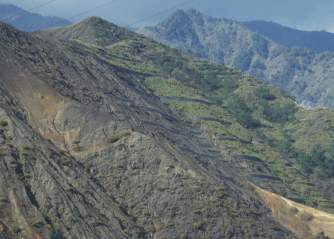November 30, 2004
-
Asia Faces Living Nightmare from Climate Change
Mon Nov 29, 8:42 AM ET
By David Fogarty
SINGAPORE (Reuters) - In the decades to come, Asia -- home to more than half the world's 6.3 billion people -- will lurch from one climate extreme to another, with impoverished farmers battling droughts, floods, disease, food shortages and rising sea levels.
Global warming and changes to weather patterns are already occurring and there is enough excess carbon dioxide and other greenhouse gases in the atmosphere to drive climate change for decades to come.

This image shows how black carbon can change rainfall patterns over the northern and southern regions of China. The blue colors indicate regions in which the simulations yield a tendency for increased rainfall by as much as 10 inches over the summer. Other regions (brown colors) have decreased rainfall by as much as several inches or more.
According to predictions, glaciers will melt faster, some Pacific and Indian Ocean islands will have to evacuate or build sea defenses, storms will become more intense and insect and water-borne diseases will move into new areas as the world warms.
All this comes on top of rising populations and spiraling demand for food, water and other resources. Environmental degradation such as deforestation and pollution will likely magnify the impacts of climate change.

The deforestation is occurred in the area around the Ashio copper processing plant in Japan. The processing plant used fuel woods, which was collected from the forest around the plant
Japan was hit by a record 10 typhoons and tropical storms this year, while two-thirds of Bangladesh, parts of Nepal and large areas of northeastern India were flooded, affecting 50 million people, destroying livelihoods and making tens of thousands ill.
The year before, a winter cold snap and a summer heat wave killed more than 2,000 people in India.
India, with a population of just over 1 billion people, is one of the areas most threatened by climate change.

Millions were made homeless by 1998 flooding in Bangladesh
Rising sea levels will also bring misery to millions in Asia, causing sea water to inundate fertile rice-growing areas and fresh-water aquifers, making some areas uninhabitable.
India and Bangladesh will have to draw up permanent relocation plans for millions of people.
By 2050, China will have built sea defenses along part of its low-lying, storm-prone southeastern coast, while the North of the country faced increasing desertification.

The Gobi Desert in China expanded by 20,230 square miles between 1994 and 1999, creeping closer to the capital Beijing.
About 15 percent of the country would be under water if sea levels rose by a yard in the next century.
Perhaps the biggest threat to Asia in the future will be the shortage of clean water. Asia accounts for 60 percent of the world's population but has only 36 percent of the globe's fresh water.

Indian tribal women fill drinking water in their pitchers. According to U. N. estimates, around 2.3 billion people in some 50 nations in the world will be saddled with severe water shortages by 2020 because of global warming.
Rapid melting of glaciers poses a major threat to the Indian Subcontinent, Southeast Asia and parts of China.
Seven major rivers, including the Ganges, Indus, Brahmaputra and the Mekong, begin in the Himalayas and the glacial meltwater during summer months is crucial to the livelihoods of hundreds of millions of people downstream.

Mount Everest should be put on a United Nations danger list as global warming threatens the Himalayan region, environmentalists said on November 16, 2004. Friends of the Earth said melting glaciers had swollen Himalayan lakes and could create floods.
But many of these glaciers are melting quickly and will be unable to act as reservoirs that moderate river flows. This means less water in the dry season and the chance for more extreme floods during the wet season.
Fears of mass migration have already prompted the Pentagon and the Canadian Security Intelligence Service, among others, to study the risk from climate-induced mass migration.
"As global and local carrying capacities are reduced, tensions could mount around the world," it said. This could lead some wealthier nations becoming virtual fortresses to preserve their resources.
"Less fortunate nations, especially those with ancient enmities with their neighbors, may initiate struggles for access to food, clean water, or energy."
Comments (3)
O_O Holy smokes that's not good.
Scary.
Those crazy Asians have a lot more to face than that. Crazy rice burners!
Comments are closed.